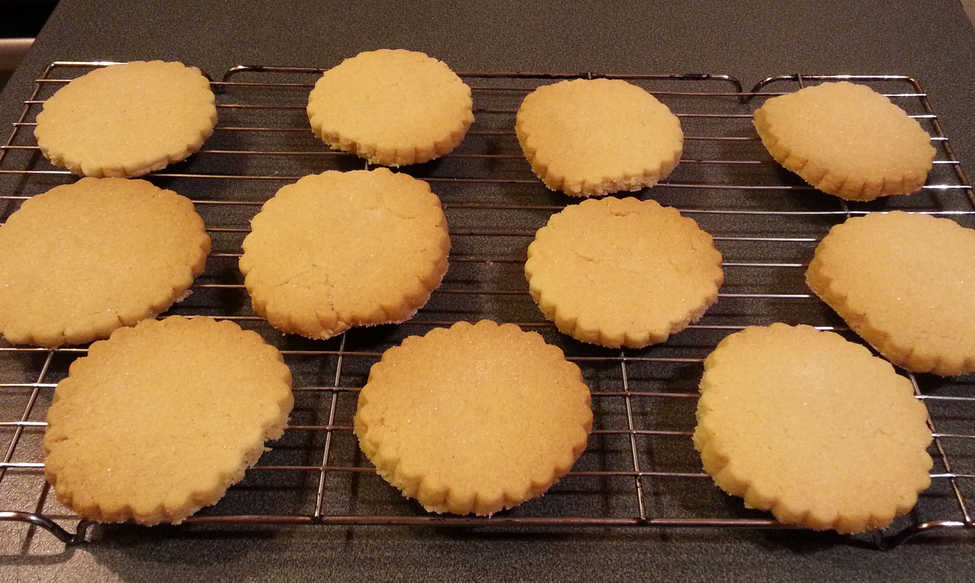
Gie her a Golden Haggis

Gag His Sadder Oats mashed on Burns Night
17 letters
Is what I'd put, if I were a crossword-puzzle writer.
It's offal time again - seems to come around earlier every year!
Since the yacht club turned down my home-made haggis for their Burns' supper, I had to entertain myself and a few chosen friends with a supper of our own.
Some friends have sturdier constitutions than others - and better late than never eh Aidan & Jude?
Anyway, this year's piece of resistance was the one, the only, the fabulous Golden Haggis™.
I had the idea last year, but didn't get round to making any haggis then, so this year it is. It takes a bit of time (and money) tracking down decent gold foil and it's damn tricky to work with too. I doubt I'll be getting much practice with it. I imagined it might go on smoother than it did - the Golden Haggis looked a teeny bit scabrous.
Still bloody magnificent though - the yacht club's loss I reckon.
As usual despite my detailed itinerary - I had a bit of a struggle getting everything ready at the same time, what with fiddling decorating the Golden Haggis and all.
Making (and cooking up) the haggis itself only took me an evening after work though. Say 5 hours. So no excuses for the rest of you.
Must investigate ways of keeping mashed potatoes (and neeps) warm without drying them out. It would make life a lot easier
Be sure to keep those potato skins too - you can fill them with haggis, top with potato, cover with cheese and bake them as a little haggis snack.
When later you have enough haggis to feed an army and no army to feed.
That is one of the drawbacks of making haggis. You have to make sooooo much! Thank God it's only once a year.
menu
Starter
Cock-a-Leekie Soup
Oatmeal Bread
Duck Liver Paté - the Christmas version
Haggis Course
Golden Haggis
Roast Brussels Sprouts and Bacon
Dessert
Lemon Syllabub - this time WITH spun sugar
and
Shortbread
Cock-a-Leekie Soup
Oatmeal Bread
Duck Liver Paté - the Christmas version
Haggis Course
Golden Haggis
That's golden people!
Chicken Suprême
for those unable, or unwilling, to take their haggis like a Scotsman.
Garlic, Cream and Butter Champit Tattis
Hmmm you know what? It occurs to me that truffled mashed potatoes might have been more in keeping with the GOLD.
Mashed Neeps & Carrots
with ginger and Grand MarnierRoast Brussels Sprouts and Bacon
Dessert
Lemon Syllabub - this time WITH spun sugar
and
Shortbread
Cock-a-Leekie Soup
Chicken and leek soup
soup fowl
First grab your cock.
Sorry. It just seemed wildly appropriate.
This recipe will feed 4 without compromising the stock, but if you thinned it out (or didn't reduce it) you could feed 8.
Otherwise you'll have to do something with all the extra chicken you can't fit into 4 soups.
Allow ½ leek per person.
I like to have the soup quite thin with just a little bit of rice, so 50g is plenty for four. But if you want to pile it in, cook more.
Sorry. It just seemed wildly appropriate.
This recipe will feed 4 without compromising the stock, but if you thinned it out (or didn't reduce it) you could feed 8.
Otherwise you'll have to do something with all the extra chicken you can't fit into 4 soups.
Allow ½ leek per person.
I like to have the soup quite thin with just a little bit of rice, so 50g is plenty for four. But if you want to pile it in, cook more.
Serves 4 generously
Ingredients
For the stock:- 1 chicken
- 2 leeks, chopped
- 2 carrots, peeled, chopped
- bunch thyme
- few bay leaves
- half dozen white peppercorns
- 1 onion, quartered
For the soup:- 2 leeks
- 4 ready-to-eat prunes 1 per person
- ¼cup/50g Basmati rice
- parsley, leaves only
- freshly ground white pepper
Chop the stock vegetables, wash the leeks thoroughly.
Cover the chicken, herbs, and stock vegetables in cold water, and bring to the gentlest of simmers. Do not boil. Allow the surface to tremble for 30 minutes, until cooked through, remove the chicken and strip off the meat, break into pieces and reserve.
Return the carcass to the pot and continue simmering for another couple of hours.
Strain the stock.
Put the rice to soak for an hour or so. Slice the soup leeks into rounds and rinse thoroughly.
Reduce (or thin) the stock until you have enough for the servings you need - about 2 cups per person. When you have the right quantity, season the stock. In the simmering stock:
To serve, bring the saved ingredients up to room temperature (if you were keeping them in the fridge). Put a prune in each warmed serving bowl.
Load with rice, leek, chicken pieces, and parsley. Pour over the hot stock.
Cover the chicken, herbs, and stock vegetables in cold water, and bring to the gentlest of simmers. Do not boil. Allow the surface to tremble for 30 minutes, until cooked through, remove the chicken and strip off the meat, break into pieces and reserve.
Return the carcass to the pot and continue simmering for another couple of hours.
Strain the stock.
Put the rice to soak for an hour or so. Slice the soup leeks into rounds and rinse thoroughly.
Reduce (or thin) the stock until you have enough for the servings you need - about 2 cups per person. When you have the right quantity, season the stock. In the simmering stock:
- Cook the sliced leeks for 10 minutes. Drain. Cool quickly in plenty of cold water. Set aside.
- Cook the rice for 10 minutes until soft. Drain. Cook quickly in plenty of cold water. Set aside.
- Cook the whole prunes for 10 minutes. Drain. Splash with cognac. Set aside.
- Blanch the parsley in a sieve. Drain. Cool quickly in plenty of cold water. Set aside. Actually, this made my parsley a bit slimy, but I do want to soften it slightly. Maybe try a quicker blanch?
To serve, bring the saved ingredients up to room temperature (if you were keeping them in the fridge). Put a prune in each warmed serving bowl.
Load with rice, leek, chicken pieces, and parsley. Pour over the hot stock.
Completely Karl™
The Golden Haggis
main meat
A dream realised!
Serves a Burns' supper
Ingredients
- haggis
- gold leaf
Reheat your cooked haggis as normal.
Make sure it's good and dry, then using a paint brush or a pastry brush, delicately paste the gold leaf sheets onto the haggis. You probably won't be able to get all the way round, so conceal the uncovered parts with mashed potato and parsley piled up around the haggis. Hopefully doing a better job of it than I did!
Serve to the astonishment and delight of the assembled guests.
Make sure it's good and dry, then using a paint brush or a pastry brush, delicately paste the gold leaf sheets onto the haggis. You probably won't be able to get all the way round, so conceal the uncovered parts with mashed potato and parsley piled up around the haggis. Hopefully doing a better job of it than I did!
Serve to the astonishment and delight of the assembled guests.
You can get your gold leaves here. Very good they are too
- just don't breathe while you apply 'em.
Haggis IV
main meat
Given the variability in the size of a sheep's innards (the pluck), the spice quantities are only a rough guide.
You might need more. You might need less. (I've never needed less!)
I haven't tried adding ginger, however I understand it's quite common. This time I included two or three teaspoons of mild smoked Spanish paprika and about ¼ teaspoon of cayenne. Once again I didn't add any (fresh or dried) herbs, though it's a definite consideration. On the whole, this year I felt I slightly under-seasoned the mixture. And last year I had a touch too much cayenne. So don't believe a word of my recipes - even if they were all perfectly edible haggii in the end!
This year's notable education came from my excellent butcher George Bower who told me how to avoid the haggis bursting while cooking - absolutely do not let the cooking water exceed 98°C. He also told me there was no need to simmer the haggis for hours, as I've been doing in the past - this being a technique for haggis made with uncooked stuffing, unlike mine. Just bring the haggis pot up to temperature and leave the beast to cool in the water. I have to say I was slightly dubious about the truncated cooking time but it worked like a charm. They were all perfectly well cooked and not one of my haggii burst, which has been a persistent problem in the past.
So thanks Mr Bower!
I came across one oddity this year - an actual sheep's stomach!
The story is slightly long and dull; basically I thought I'd try and order the haggis bits from a decent butcher I've recently discovered near where I work in Musselburgh, rather than trekking out to that ever-reliable but distant George Bower at the crack of dawn.
I placed my order, went the next day to confirm everything would be delivered, then returned a week later to collect the winnings. Only to discover that the ox bungs (fat intestinal stockings which are now used to wrap the haggis) were unavailable. Not Aytouns' fault, but a bit of a pisser nevertheless, since it now required a trip to George Bower anyway - the thing I'd been trying to avoid.
Anyhoo, Mr Aytoun did happen to have some actual sheep's stomachs (the traditional haggis casing) in the freezer so he offered me them in compensation.
I took them home and defrosted them to have a shufty, and was astonished at their overall tattiness. Thick as boot leather and hairy like tripe well DUH!, they were also full of nodules and holes - obviously one big hole where the food goes in, a smaller hole where the poo goes out, but lots of other mysterious orifices where who-knows-what passes through. I had thought that the stomachs became unavailable due to Foot-And-Mouth disease, or was it Scrapie? But perhaps they become unavailable simply because they're shit? I could see how you could use 'em to make a haggis, but it would be strangely deformed looking thing with a lot of billowing skirts hanging off it like a badly-stuffed jelly fish. Not the look I was going for, so I stuck with Mr Bower's thin, smooth, two-foot long ox bungs.
Thanks Mr Bower!
I haven't tried adding ginger, however I understand it's quite common. This time I included two or three teaspoons of mild smoked Spanish paprika and about ¼ teaspoon of cayenne. Once again I didn't add any (fresh or dried) herbs, though it's a definite consideration. On the whole, this year I felt I slightly under-seasoned the mixture. And last year I had a touch too much cayenne. So don't believe a word of my recipes - even if they were all perfectly edible haggii in the end!
This year's notable education came from my excellent butcher George Bower who told me how to avoid the haggis bursting while cooking - absolutely do not let the cooking water exceed 98°C. He also told me there was no need to simmer the haggis for hours, as I've been doing in the past - this being a technique for haggis made with uncooked stuffing, unlike mine. Just bring the haggis pot up to temperature and leave the beast to cool in the water. I have to say I was slightly dubious about the truncated cooking time but it worked like a charm. They were all perfectly well cooked and not one of my haggii burst, which has been a persistent problem in the past.
So thanks Mr Bower!
I came across one oddity this year - an actual sheep's stomach!
The story is slightly long and dull; basically I thought I'd try and order the haggis bits from a decent butcher I've recently discovered near where I work in Musselburgh, rather than trekking out to that ever-reliable but distant George Bower at the crack of dawn.
I placed my order, went the next day to confirm everything would be delivered, then returned a week later to collect the winnings. Only to discover that the ox bungs (fat intestinal stockings which are now used to wrap the haggis) were unavailable. Not Aytouns' fault, but a bit of a pisser nevertheless, since it now required a trip to George Bower anyway - the thing I'd been trying to avoid.
Anyhoo, Mr Aytoun did happen to have some actual sheep's stomachs (the traditional haggis casing) in the freezer so he offered me them in compensation.
I took them home and defrosted them to have a shufty, and was astonished at their overall tattiness. Thick as boot leather and hairy like tripe well DUH!, they were also full of nodules and holes - obviously one big hole where the food goes in, a smaller hole where the poo goes out, but lots of other mysterious orifices where who-knows-what passes through. I had thought that the stomachs became unavailable due to Foot-And-Mouth disease, or was it Scrapie? But perhaps they become unavailable simply because they're shit? I could see how you could use 'em to make a haggis, but it would be strangely deformed looking thing with a lot of billowing skirts hanging off it like a badly-stuffed jelly fish. Not the look I was going for, so I stuck with Mr Bower's thin, smooth, two-foot long ox bungs.
Thanks Mr Bower!
Makes enough to feed a couple of dozen people
Ingredients
- 1kg/2 lb liver
- 300g/10 oz heart
- 300g/10 oz kidney
- 500g/1 lb lungs
- 500g/1lb kidney suet lamb preferably, though beef will do
- 2 cups/320g/11oz pinhead oatmeal
- 1 cup pearl barley, cooked
- 2 medium onions, chopped
- ½ head of garlic, minced
- glass Armagnac
- 2 ox ceca or bungs, well-washed
Definite Spices:- 1 tsp ground black pepper or more to taste
- 1 tsp salt or more to taste
- 1 tsp ground mixed coloured peppercorns (green & red)
- 1 tsp ground mace
- 1 tsp ground nutmeg
- 1 tsp ground allspice
Optional Spices:- cayenne pepper, perhaps a teaspoon optional but a little is nice
- paprika, perhaps a few teaspoons optional
- ginger powder optional
- herbs of choice - marjoram/savory/sage/thyme/lovage/mint/pennyroyal/rosemary optional
Put the sheep pluck (everything but the suet) into a pot of water and bring to the boil (assuming you have a large enough pot;
otherwise you will have to do this in stages re-using the cooking water in between).
Simmer each component as long as necessary to cook it through - 20 minutes for the kidneys, about half an hour for the liver and heart, as much as 2 hours for the lungs. Drain, strain and retain the offal stock. Remove any skin, lumps, veins or mysterious nodules from the liver and kidneys (and discard any rubbery bits you missed as you grate them later).
Cook the barley in two to three times its volume of the stock until tender (about 45 minutes), adding a little salt, pepper and mace seasoning too.
Toast the oatmeal in a large dry frying pan (or in batches) until it smells toasty(!) and takes on a little more colour. Watch you don't burn it. Or apparently dry-roast in the oven for 10 minutes at 175°C/350°F/Gas Mark 4.
Pull out (and discard) the larger capillaries from the lungs and heart then blend them up with enough stock to achieve a smooth paste.
Now season this mixture - start with about half your spice mix, stir it in, then fry up a sample and taste. Adjust seasoning and repeat until you're happy.
Your haggis stuffing is now ready.
Thoroughly rinse the ox ceca inside and out, then stuff them with the haggis mixture. You get to choose how large each individual haggis is going to be, just tie off the sizes you want with a few turns of string, leave a good couple of inches of cecum (for cutting the haggis apart), tie off again, and fill the next haggis. I found filling the sock to capacity, then squeezing it out to a bit more than half-full before tying that section gives a nicely swollen haggis when cooked, but leaves enough room for expansion. Alternative, leave two or three fingers of empty sock at the end of each packed haggis before tying off, then squeeze the filling around so its evenly distributed. An over-stuffed haggis is more likely to burst during cooking.
To cook the haggis bring a large pot of water to the boil, then turn the heat off. Lower the raw haggii into the pot, turn the heat on low and gently reheat to 98°C no hotter (this might take an hour). Immediately turn off the heat and leave the pot, covered, to completely cool.
Remove the haggii, drain and pat dry.
Your haggii are now cooked and unsplit!
You can keep these haggii (cool and dry) for a week or two Mr Bower says a week and a day, which is both deliciously arbitrary and nicely specific or freeze them for later.
To serve, simply reheat them, again by immersing in water not more than 98°C (repeating the above process works perfectly), though you can roast regularly basted with fat at Gas Mark 6 for 1 hour will also give you an edible crispy skin, pan-fry, or batter and deep-fry them as you prefer.
Simmer each component as long as necessary to cook it through - 20 minutes for the kidneys, about half an hour for the liver and heart, as much as 2 hours for the lungs. Drain, strain and retain the offal stock. Remove any skin, lumps, veins or mysterious nodules from the liver and kidneys (and discard any rubbery bits you missed as you grate them later).
Cook the barley in two to three times its volume of the stock until tender (about 45 minutes), adding a little salt, pepper and mace seasoning too.
Toast the oatmeal in a large dry frying pan (or in batches) until it smells toasty(!) and takes on a little more colour. Watch you don't burn it. Or apparently dry-roast in the oven for 10 minutes at 175°C/350°F/Gas Mark 4.
Pull out (and discard) the larger capillaries from the lungs and heart then blend them up with enough stock to achieve a smooth paste.
You need to strip out the larger capillaries from the lungs no matter how long you cook them,
but it's definitely the case that they disintegrate more easily the longer they're cooked so give them at least an hour.
Otherwise you'll end up with practically nothing after a great deal of tedious picking over.
You can just mince some of the nicer bits of heart, but it does make a really good purée, so you might not want to bother.
Into a (very) large bowl:
You can just mince some of the nicer bits of heart, but it does make a really good purée, so you might not want to bother.
- Grate the kidney.
- Grate the liver.
- Chop the onion (moderately finely - a ½cm or so dice).
- Mince the garlic.
- Chop the suet.
- Add the cooked barley.
- Add the lung and heart paste.
- Add the cognac.
Now season this mixture - start with about half your spice mix, stir it in, then fry up a sample and taste. Adjust seasoning and repeat until you're happy.
You'll probably need more black pepper and salt than the amounts listed above - add more of these separately at the end.
Go for slightly over-seasoned at this stage since the flavour will mellow and leach slightly on cooking and you haven't added the oatmeal yet,
but be a bit cautious with the cayenne if using.
Best not to test-fry the mixture with the uncooked oatmeal in since it'll just give you a load of unpleasant gravelly bits.
Finally stir in the toasted oatmeal, moistening with additional stock if required.Best not to test-fry the mixture with the uncooked oatmeal in since it'll just give you a load of unpleasant gravelly bits.
Your haggis stuffing is now ready.
Thoroughly rinse the ox ceca inside and out, then stuff them with the haggis mixture. You get to choose how large each individual haggis is going to be, just tie off the sizes you want with a few turns of string, leave a good couple of inches of cecum (for cutting the haggis apart), tie off again, and fill the next haggis. I found filling the sock to capacity, then squeezing it out to a bit more than half-full before tying that section gives a nicely swollen haggis when cooked, but leaves enough room for expansion. Alternative, leave two or three fingers of empty sock at the end of each packed haggis before tying off, then squeeze the filling around so its evenly distributed. An over-stuffed haggis is more likely to burst during cooking.
To cook the haggis bring a large pot of water to the boil, then turn the heat off. Lower the raw haggii into the pot, turn the heat on low and gently reheat to 98°C no hotter (this might take an hour). Immediately turn off the heat and leave the pot, covered, to completely cool.
Remove the haggii, drain and pat dry.
Your haggii are now cooked and unsplit!
You can keep these haggii (cool and dry) for a week or two Mr Bower says a week and a day, which is both deliciously arbitrary and nicely specific or freeze them for later.
To serve, simply reheat them, again by immersing in water not more than 98°C (repeating the above process works perfectly), though you can roast regularly basted with fat at Gas Mark 6 for 1 hour will also give you an edible crispy skin, pan-fry, or batter and deep-fry them as you prefer.
As usual, the haggis was perfectly acceptable, in fact it seems pretty hard to go wrong. Though this time they were also magnificently unburst!
Some thoughts overall on this year's performance:
Some thoughts overall on this year's performance:
- You could just run the meat and onion through a meat grinder - which would save puréeing the lungs and all that tedious grating. But might leave you with an over-abundance of rubbery tubules?
- I was slightly worried I hadn't chopped the onion finely enough since they seemed a bit chunky in the mixture, but it came out just fine in the end.
- Despite frying and tasting haggis samples, I still ended up with slightly under-spiced haggis. Slightly. I think I'll try a heavier hand next time, though perhaps not with the cayenne.
- Next time I'll leave a bit more of a gap between the individual haggii along the bung - I was afraid they'd leak once I cut them apart for reheating. Fortunately they were fine.
Chicken Suprême
main fowl
I happened to have a chicken breast left over from cock-a-leekie soup
so I just reheated that by simmering it in the chicken stock.
But you can use a roast chicken breast, a pan-fried chicken breast,
or even go to the trouble of stuffing herb-and-spiced-butter under a nice, fresh breast's skin,
pan-frying it to start with, then popping the pan in the oven to finish it off.
Or you could use diced chicken of course. Philistine.
Or you could use diced chicken of course. Philistine.
Serves One Per Breast
Ingredients
- chicken breast
- light chicken stock
- butter
- plain flour
- double cream
- white wine optional
- bacon, diced optional
- mushrooms, sliced optional
- lemon juice optional
- herbs optional
- paprika and chives to decorate - optional
Cook the chicken breast however you like. Keep warm.
Meanwhile fry your bacon and mushroom slices until they are cooked and beginning to collapse. Set aside.
Reduce the chicken stock if it's thin, and make a velouté:
Reduce the white wine by half if using and add to the sauce, then stir in warmed heavy cream. Season with salt, pepper and a little lemon juice if you like.
You now have Sauce Supréme.
Add the bacon and mushrooms if using.
Flavour with herbs, like savory if you can find it if you like.
Slice up the chicken breast, decorate with a scattering of paprika and chives if you like and serve over the sauce supréme.
Meanwhile fry your bacon and mushroom slices until they are cooked and beginning to collapse. Set aside.
Reduce the chicken stock if it's thin, and make a velouté:
- Make a roux from equal volumes of flour and butter and cook until it is a blond colour.
- Gradually whisk in the stock and bring to a gentle simmer for 45 minutes to 1 hour, adding stock if necessary, until the smooth sauce thinly coats the back of a spoon (napé)
- If you do this with only half of the pan over the heat any scum should collect on the cooler side where you can scoop it away.
Reduce the white wine by half if using and add to the sauce, then stir in warmed heavy cream. Season with salt, pepper and a little lemon juice if you like.
You now have Sauce Supréme.
Add the bacon and mushrooms if using.
Flavour with herbs, like savory if you can find it if you like.
Slice up the chicken breast, decorate with a scattering of paprika and chives if you like and serve over the sauce supréme.
A good way to use up chicken left over from your cock-a-leekie soup.
Ignore any moaning about having the same meat for both starter and main course - if they wanted a different meat they should have eaten the haggis.
Ignore any moaning about having the same meat for both starter and main course - if they wanted a different meat they should have eaten the haggis.
Shortbread
dessert veg
I took Shirley Spear's shortbread recipe from the Three Chimneys Restaurant on Skye
and just slightly increased the amount of sugar.
I'm a sucker for sugar.
I'm a sucker for sugar.
Makes about a dozen 7cm/2½" rounds
Ingredients
- 150g plain flour
- 150g butter
- 50g rice flour
- 60g caster sugar
- pinch of salt
Cream the butter and sugar thoroughly together with a pinch of salt.
Cut in the (well-)sieved flours with a fork until it's looking like breadcrumbs. Gather into a ball, flatten on a lightly floured surface, sieve a little flour over the top and gently flatten to a 1cm/½" sheet without kneading or rolling too much.
Using a fluted 6cm or 7cm cookie cutter cut out about a dozen cookies (they'll expand a little as they cook). Cover a baking sheet with non-stick parchment. Lay out the cookies on the sheet and prick well with a fork.
Put the sheet and cookies in the fridge for 15 mins to chill.
Preheat the oven to Gas Mark 3.
Cook the biscuits for 20-40 minutes until cooked, firm, and lightly coloured but not browning. 30 minutes worked for me.
Sprinkle with caster sugar as soon as the biscuits come out of the oven, leave them a couple of minutes, then slide them onto a rack with a palette knife to cool.
Cut in the (well-)sieved flours with a fork until it's looking like breadcrumbs. Gather into a ball, flatten on a lightly floured surface, sieve a little flour over the top and gently flatten to a 1cm/½" sheet without kneading or rolling too much.
Using a fluted 6cm or 7cm cookie cutter cut out about a dozen cookies (they'll expand a little as they cook). Cover a baking sheet with non-stick parchment. Lay out the cookies on the sheet and prick well with a fork.
Put the sheet and cookies in the fridge for 15 mins to chill.
Preheat the oven to Gas Mark 3.
Cook the biscuits for 20-40 minutes until cooked, firm, and lightly coloured but not browning. 30 minutes worked for me.
Sprinkle with caster sugar as soon as the biscuits come out of the oven, leave them a couple of minutes, then slide them onto a rack with a palette knife to cool.
Delicious.
Even if you do forget to prick the damn things with a fork.
Even if you do forget to prick the damn things with a fork.
You can also make traditional finger or wedge-shaped shortbreads by pressing the mixture into a shallow baking tin with the back of a spoon.
Butter the tin first and sieve icing sugar into it.
Mark the shapes you want into the mixture with a knife before cooking (and prick with a fork!), then cut them through again after baking while the shortbreads are still hot. Leave them to cool a little before easing them out of the tin. You'll probably lose the first one. Or two :)
Mark the shapes you want into the mixture with a knife before cooking (and prick with a fork!), then cut them through again after baking while the shortbreads are still hot. Leave them to cool a little before easing them out of the tin. You'll probably lose the first one. Or two :)
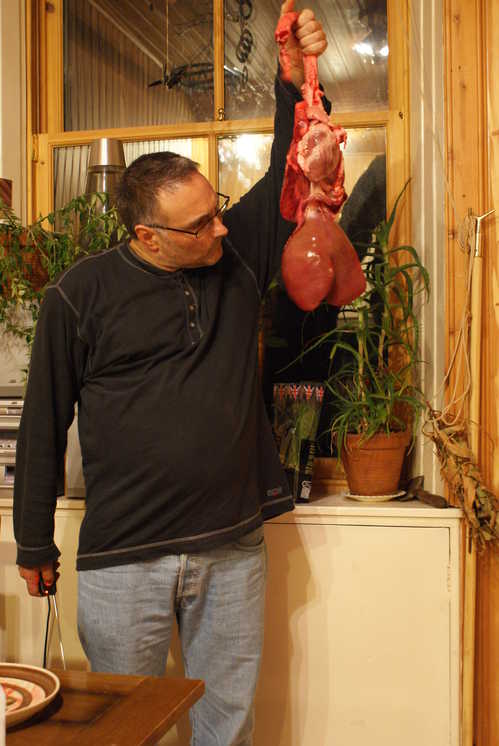
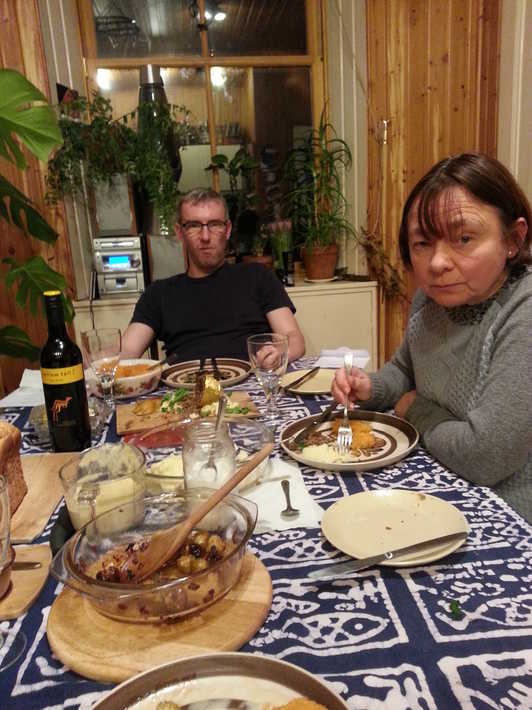
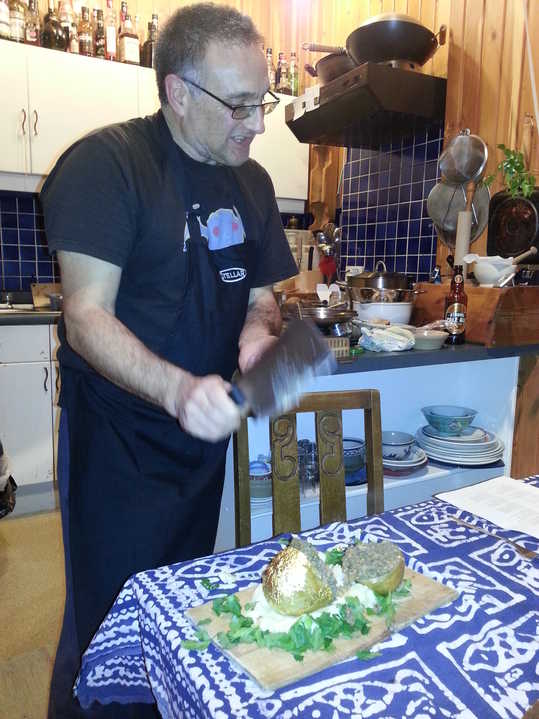
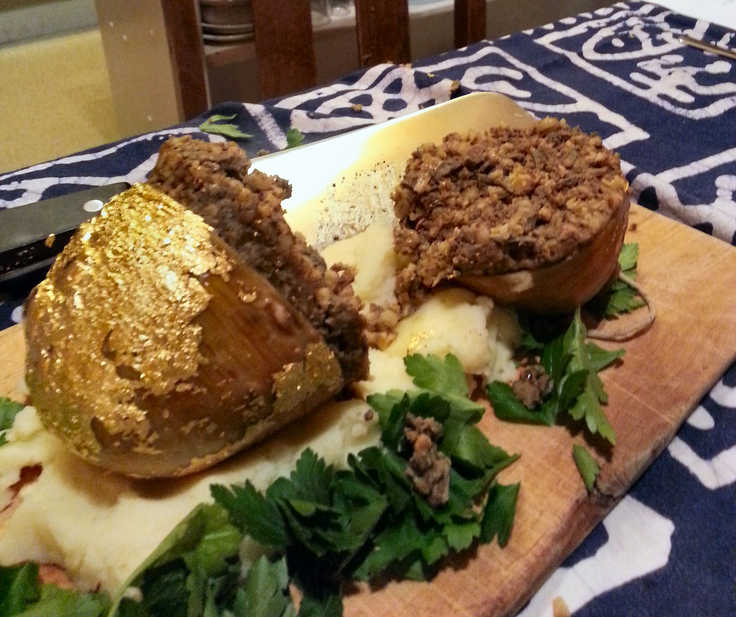
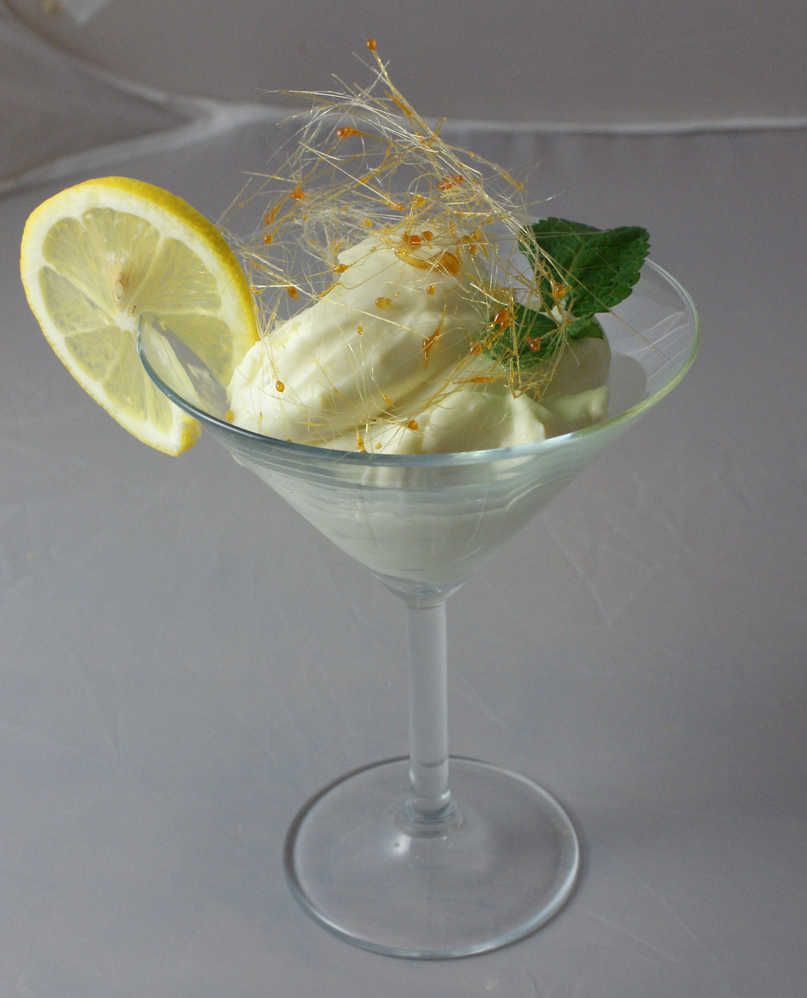
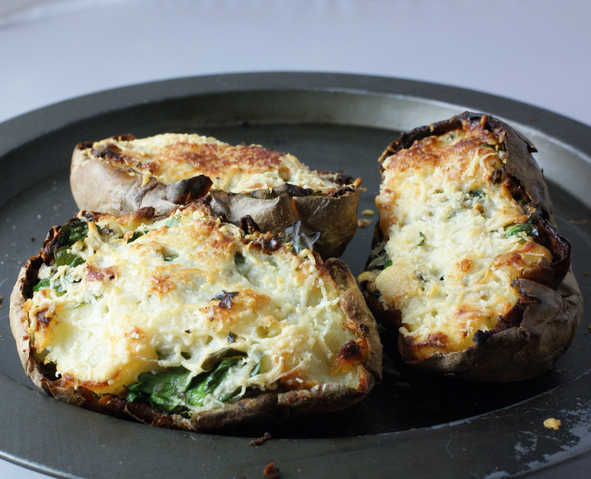
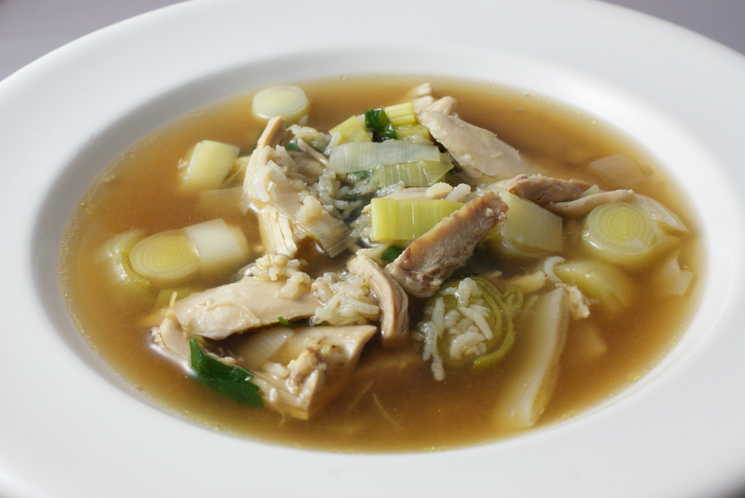
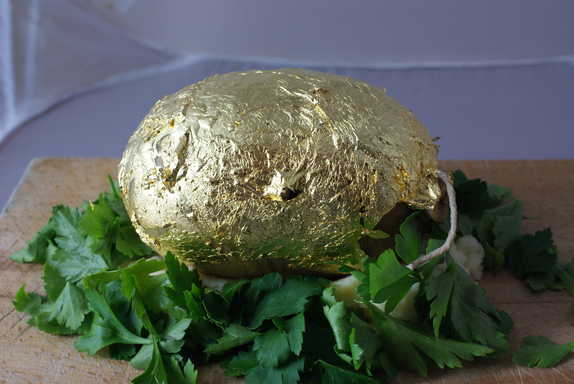
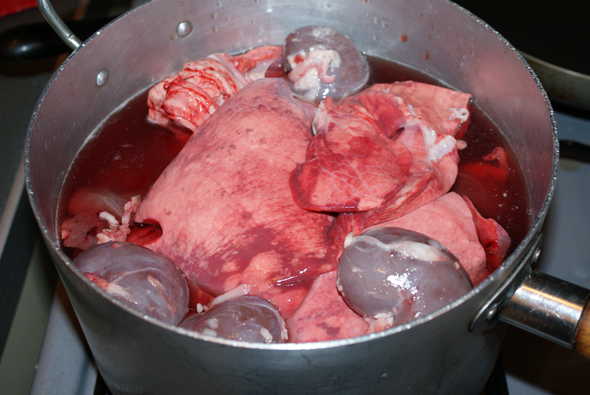
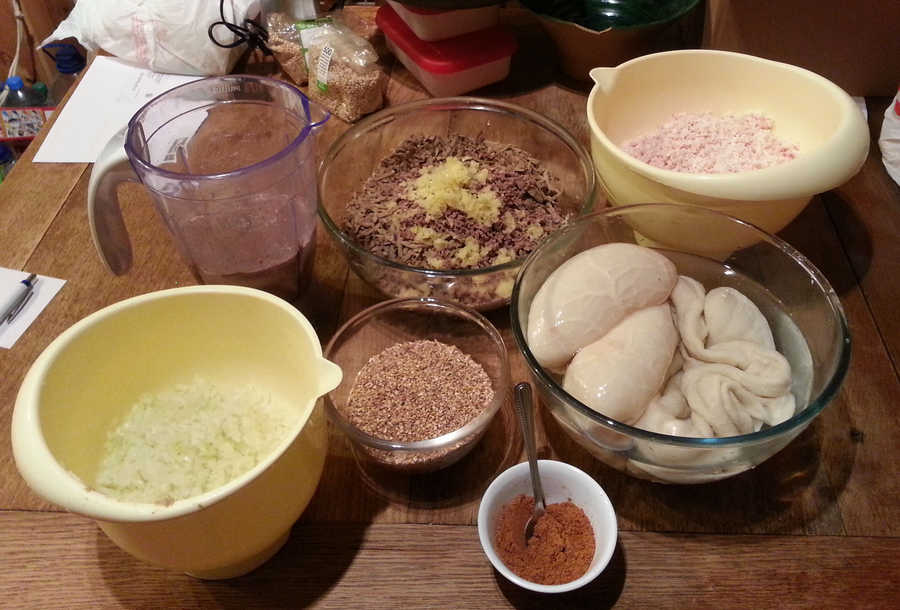
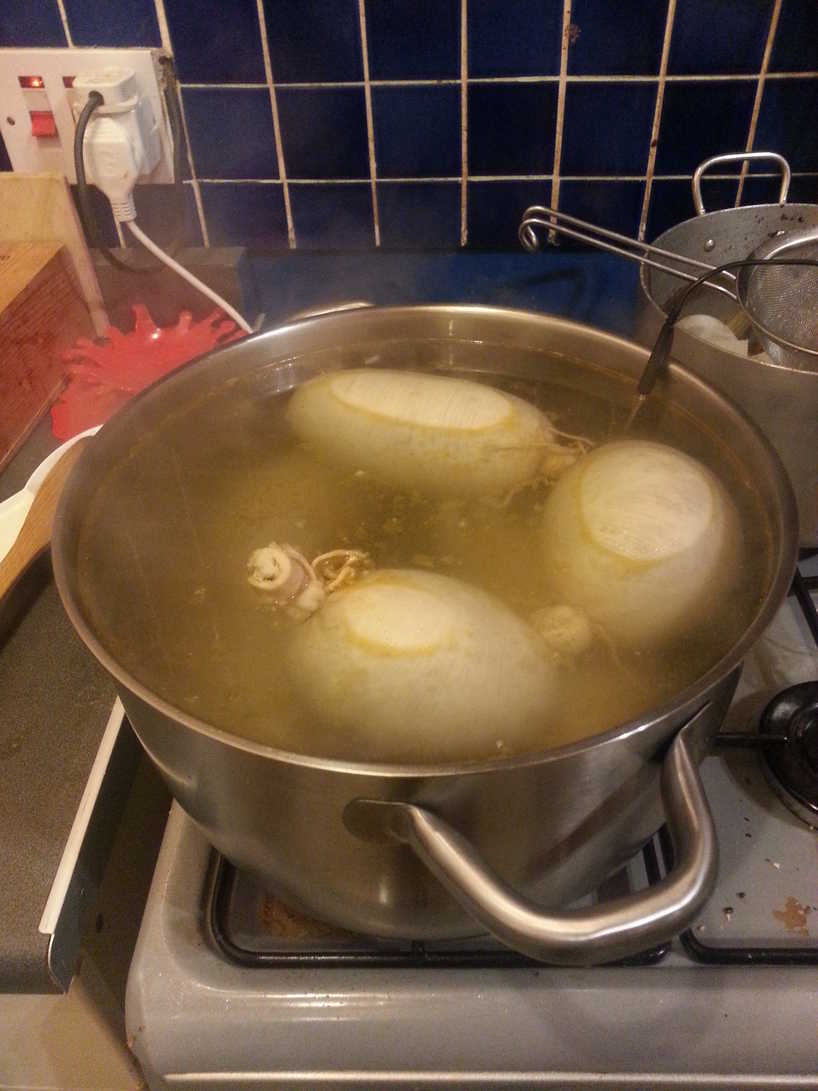
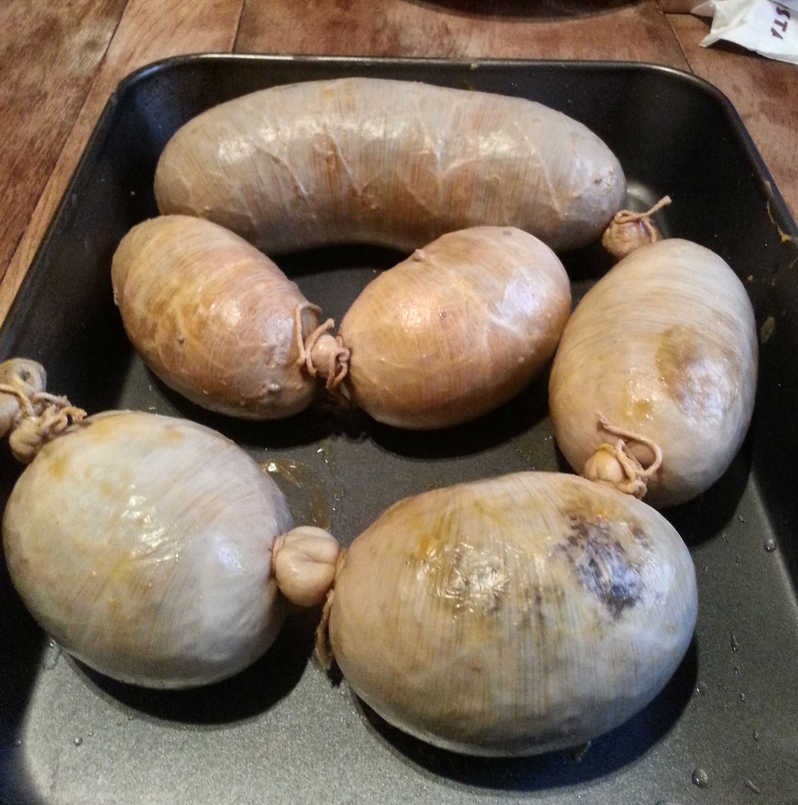
You could serve garnished with chives instead of parsley. Barley instead of rice. Your call.